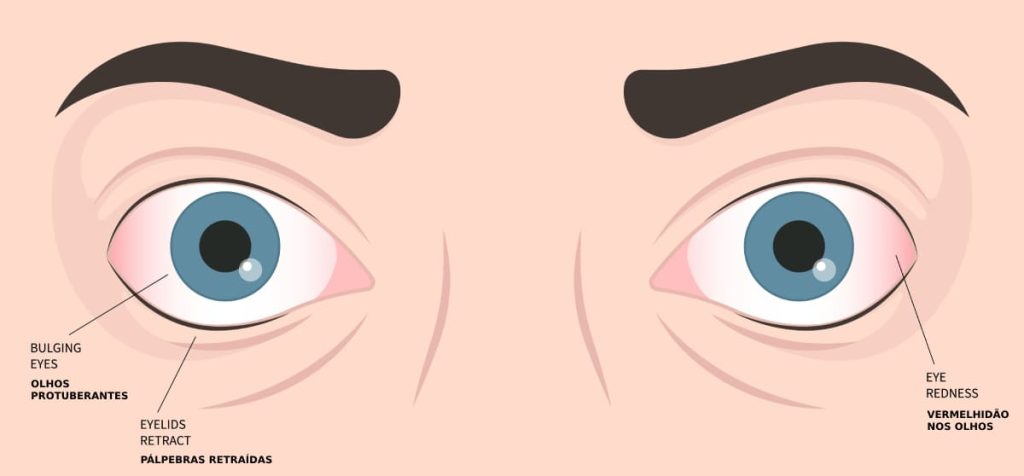Orbital diseases, also known as eye socket diseases, are conditions that affect the tissues and structures located in the bony cavity… See more →

Are you experiencing eye bulging, vision changes, or eye pain? These could be signs of orbital diseases – complex conditions affecting the tissues surrounding your eyes.our surgical team works along with an Ophthalmology center, to offer expert care for these challenging eye disorders.
Graves’ orbitopathy, also known as thyroid eye disease, is a complex condition that affects approximately 25-30% of individuals with Graves’ disease. This autoimmune disorder causes inflammation and tissue changes in and around the eyes, leading to a range of symptoms and potential complications.

The disease can range from mild to sight-threatening, with significant impacts on quality of life even in milder cases.
Abnormal growth of fat and muscle tissues within the eye socket (orbit) can cause various symptoms.
Patients may experience eye bulging (proptosis) and eyelid retraction.
Double vision and, in severe cases, vision loss can occur.
Difficulty closing eyelids can lead to dry eyes and potential corneal ulcers.
Patients with Graves’ orbitopathy may also experience symptoms related to hyperthyroidism, such as:
We offer a comprehensive, multidisciplinary approach to managing Graves’ orbitopathy:
For sight-threatening cases or those not responding to medical treatment, we offer:
For inactive or stable disease, we provide:
No, many orbital conditions are benign. However, early evaluation is crucial for proper diagnosis and treatment.
Some conditions, particularly inflammatory diseases, can be managed with medication. Each case is unique and requires personalized evaluation.
While Graves’ orbitopathy is associated with Graves’ disease (a form of hyperthyroidism), they are not the same. Graves’ orbitopathy specifically affects the eyes and surrounding tissues, and can occur even when thyroid function is normal. It requires specialized treatment beyond managing thyroid hormone levels.
Graves’ orbitopathy often goes through an active phase followed by a stable phase. While some mild cases may improve without treatment, most cases require medical management. In moderate to severe cases, or if left untreated, it can lead to permanent changes in eye appearance and function. Early intervention is key to preventing long-term complications.
If you’re experiencing symptoms of orbital disease or have been diagnosed with an orbital condition, don’t wait. Contact us today to schedule a comprehensive evaluation with our expert team. Your vision is precious – let us help you protect it.
We offer a comprehensive, multidisciplinary approach to managing Graves’ orbitopathy:
Are benign tumours that frequently involve the orbital tissues. Surgery can be a solution when the lesion causes symptoms. In specific cases, interventional (neuro)radiology may help in vascular diagnostic angiography or therapeutic vascular embolization.
This category encompasses a wide variety of usually benign tumours, such as lipomas. Solitary fibrous tumours within this group are locally aggressive and require removal, although distant metastases are rare.
Are benign tumours that originate from neural cells. Asymptomatic cases should be monitored regularly, but surgical intervention is necessary for gliomas and meningiomas, often in collaboration with Neurosurgery.
Benign symptomatic tumours are surgically removed while preserving the eye structure. Malignant cases require prompt and radical excision.
Lymphoma, particularly MALT lymphomas, are not uncommon and require a biopsy for confirmation. Treatment is managed by a Hematologist using appropriate drugs.
Eyelid and facial skin tumours can invade the orbit and should be surgically removed. A new drug (vismodegib) enlarges the treatment options for selected patients with unresectable or potentially eye-threatening basal cell carcinoma. Still, its prescription must be approved and directed by an oncology board. Radiotherapy is a valid option for certain orbital-invading skin tumours.
Lesions originating from thelacrimal sac and nasal sinus can also invade the orbit and should be referred to a surgeon.
Although rare, these tumours must also be surgically removed.